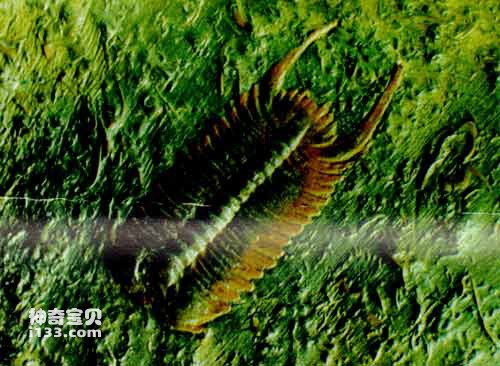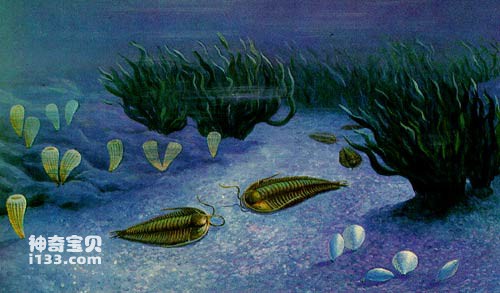As early as more than 300 years ago during the Chongzhen period of the Ming Dynasty, a man named Zhang Huadong discovered a "monster" buried in rocks in Dawenkou, Tai'an, Shandong Province. Its appearance looked like a bat spreading its wings, so he created it for him. It was named "Bat Stone". In the 1920s, Chinese paleontologists conducted scientific research on the "bat stone" and finally figured out that it was the tail of a trilobite. This trilobite lived in the late Cambrian period 500 million years ago and was an arthropod in the ocean. In order to commemorate the first name given to trilobites in the world, Chinese scientists translated the Latin name of this trilobite into Chinese and still called it "bat stone" or "bat bug".

Trilobite
The earliest records of studying trilobites abroad can be traced back to 1698. At that time, Rude named a trilobite fossil with three round tumors on its head "trilobite". By 1771, Varchi based on the morphological characteristics of this animal, that is, the body can be divided into three parts vertically and horizontally: vertically into the head, thorax and tail, and horizontally into the central axis and its sides on both sides. The leaf part gives it an appropriate name - "trilobite".

The Trilobite World of the Cambrian
In animal taxonomy, trilobites belong to the phylum Vertebrates and the class Trilobites. They lived in the ancient oceans, mainly appeared in the Cambrian period, and reached their peak in the late Cambrian period. Since then, trilobites have declined from their peak of prosperity to extinction at the end of the Permian, and did not enter the Mesozoic. Trilobites have flourished throughout the long geological history of more than 300 million years in the Paleozoic era, and have reproduced numerous groups and huge numbers. There are more than 1,500 genera and more than 10,000 species in total, of which about 1,000 are found in my country. 500 genera.
Most trilobites are oval or oval in shape, but their individual sizes vary widely. Found in the Ordovician strata of Portugal, Schizophora uraeus is one of the largest trilobites, reaching a length of 70 centimeters. However, tiny trilobites such as Archaea and Glomerula are only less than 6 mm. Common trilobites are generally 3 to 10 cm in length and 1 to 3 cm in width. Anything over 20 centimeters is considered large. A 30-centimeter-long Laidelichia was discovered in the early Cambrian strata of Kunming, my country.
Trilobite fossils are widely distributed around the world and are therefore very important for dividing strata. But at the same time, many trilobite genera and species have local characteristics, so they are of great significance in dividing the sea areas at that time and restoring the biogeographical flora at that time.
Although trilobites lived a long time ago, scientists have a fairly complete understanding of its morphology, structure and other characteristics. The main reasons are as follows: First, the surface of the trilobite body is covered with a strong carapace. They experienced multiple shelling and growth during their ontogeny, so they left more fossils in the strata than other organisms; secondly, there were few animals larger and more ferocious than trilobites in the Cambrian ocean, and they Living together, they can reproduce quickly and distribute widely; in addition, trilobite fossils are mostly preserved in fine-textured limestone or shale, so not only the characteristics of the shell can be clearly observed, but sometimes its internal structure is also Can be seen very clearly.
The main feature of the trilobite is its dorsal shell structure. There is a protruding "saddle" in the center of its head, which may be where the brain is placed. Some of the surfaces of the saddle are smooth and unadorned, some are dotted with knobs, and some have numerous transverse grooves. These transverse grooves are called "cephalosellar grooves". There are usually pairs of eyes on both sides of the saddle. There is a groove along the front and back of the eye, called the facial line, which is where the trilobite sheds its shell and emerges from its body as it grows. There is a pair of segmented tentacles at the front end of the ventral surface of the head, which are both action and sensory organs. Behind the tentacles is the feeding mouth, usually covered with a "lip". There are many small and segmented mobile organs-appendages on both sides of the mouth. The appendages are covered with fine cilia, which presumably can play a role in breathing.
The thorax of trilobites is divided into more than ten segments, while some are only divided into two segments. The sections are connected in a shingle shape (that is, one piece is placed on top of another like a roof tile) to facilitate curling movements. There are numerous segmented appendages on both sides of the trilobite's ventral surface. The appendages have cilia, so these appendages are also used for movement and breathing. The tail of the trilobite is the same as the thorax. It is divided longitudinally into a central axis and costal leaves on both sides. Its shapes are diverse; some edges of the tail are spiny, and some are not spiny.
The living habits of trilobites are diverse. The most common type of fossils is preserved in limestone or shale. It can be seen that at that time, they mostly lived on the shallow seabed or moved on the mud. Some of them can swim a little, and some drift with the water. The entire body of the toothworms in the middle Silurian period was almost surrounded by dense long spines. These long spines were a powerful propeller for them to swim in the water, so it can be speculated that they were expert swimmers; at the same time, , these long spines are also effective weapons against natural enemies. This type of trilobite mainly appeared from the Ordovician to the Devonian period. The nautiloids, plate-footed horseshoe crabs and fish that coexisted with it at that time were all powerful enemies of trilobites. If the trilobites were not strengthened, With its swimming ability and enemy-defending weapons, how can they continue to survive and reproduce in that highly competitive environment?
Some Ordovician trilobites, such as gem bugs, strabismus, cryptocephalids, etc., also developed the ability to curl. Their heads and tails can be completely connected together, leaving only the hard shell on the back exposed; They can also burrow into the mud to protect their soft abdominal organs, which on the one hand facilitates defense against enemies and on the other hand, they can propel their bodies forward in a flexing manner similar to that of an inchworm.
For the ontogeny of trilobites, scientists usually study specimens of the same individual at different growth stages in the same layer. The ontogeny of trilobites can be roughly divided into three stages - juvenile stage, middle age and adult stage. In the juvenile stage, the head and tail of the insect are not yet distinct, and there are no thoracic segments. The diameter is approximately 0.24-1.3 mm. In the middle-aged stage, the head and tail of the insect have separated, and the thoracic segments have also developed, but the number of segments is one less than in adulthood. In the adult stage, the number of segments in the thorax and tail of the insect increases to the limit, the insect body enlarges, and appendages such as spines and tumors appear on the shell.
Since the appearance of trilobites in the early Cambrian period, the main structural characteristics of each part have gradually changed accordingly in the evolution of the entire system. These changes mainly include the following aspects: 1. Changes in the shape of the saddle: in the early Cambrian period The skull saddle shape of primitive trilobites is mostly long cone shape, and the bulge is not obvious. Later, after the middle Cambrian period, the saddle gradually shortened, and the two sides became parallel, becoming cylindrical, and some even became spherical. In the late Cambrian and later trilobites, even the boundary between the saddle and the cheeks on both sides was unclear. 2. Changes in the location of the posterior branch of the facial line: The end point of the posterior branch of the facial line (that is, the section of facial line behind the eyes) of early trilobites often intersects with the posterior edge of the head or the angle of the cheeks; later in the Ordovician Later types often intersect with the side edges of the head. 3. Eye changes: eyes of some trilobites. It is crescent-shaped at first, then gradually becomes smaller, and finally disappears. Another type of trilobite with more developed compound eyes has eyes that grow from small to large, and finally an eye stalk appears, and the eyes are located on the top of the tall eye stalk. Many Silurian trilobites fall into this category. 4. Changes in spines around the body: Cambrian and Ordovician trilobites rarely had spines, while those from the Silurian and later types had spines more frequently, and the spines were more complex than before. 5. The thoracic segments change from more to less, the tail from small to large, the transverse grooves on the saddle of the head from more to less, etc. Trends are also shown in many types of trilobites.
animal tags: Trilobite
We created this article in conjunction with AI technology, then made sure it was fact-checked and edited by a Animals Top editor.